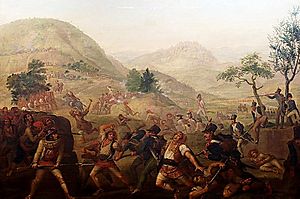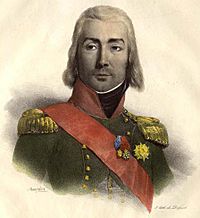Battle of Medina de Rioseco facts for kids
The Battle of Medina de Rioseco was an important fight during the Peninsular War. It happened on July 14, 1808, near Medina de Rioseco in Spain. In this battle, French forces led by Marshal Bessières fought against Spanish armies. The Spanish forces were commanded by General Joaquín Blake and General Gregorio de la Cuesta.
The Spanish wanted to cut off the French supply lines to Madrid. But their generals, Blake and Cuesta, did not work well together. This made it easier for the French to win. The battle was a big defeat for the Spanish. It hurt their fight against the French invasion.
However, this French victory was one of the few they had early in the war. Soon after, the French faced a major defeat at the Battle of Bailén. This forced them to retreat across the Ebro river. Later, Napoleon himself had to bring more troops to Spain to fix the situation.
Quick facts for kids Battle of Medina de Rioseco |
|||||||
|---|---|---|---|---|---|---|---|
| Part of the Peninsular War | |||||||
 Escena de la Guerra de la Independencia, 1808, by Joseph-Bernard Flaugier. |
|||||||
|
|||||||
| Belligerents | |||||||
| Commanders and leaders | |||||||
| Strength | |||||||
| 12,550–12,800 infantry, 950–1,200 cavalry, 32 guns |
21,300–22,000 regulars and militia, 600 cavalry, 20 guns |
||||||
| Casualties and losses | |||||||
| 400–500 dead or wounded | 1,000 dead or wounded, 1,200 missing or captured, 13 guns captured |
||||||
Contents
Why the Battle Happened
The Peninsular War was a conflict where France fought against Spain, Portugal, and Great Britain. Spain was resisting French control. The northern parts of Spain, like Galicia, were good places for resistance. They were mountainous and hard for the French army to reach. Also, the British navy could bring supplies to the coast.
In June 1808, French forces tried to secure their communication lines. But they were pushed back by local resistance. Napoleon was not happy with these results. So, he sent more troops and ordered Marshal Bessières to attack again in the west.
Meanwhile, Spanish forces were gathering. General Blake led the Army of Galicia. General Cuesta joined him with his own troops. Cuesta had been defeated earlier, but he wanted to attack the French near Valladolid. This city was important for French communications.
Spanish Army Plans
Cuesta wanted to make a quick attack on Valladolid. He had some cavalry and infantry, but no cannons. Other Spanish leaders were not sure about his plan. Blake, a skilled officer, thought it was risky to fight the French in open areas. He preferred fighting in the mountains where the French cavalry would not have an advantage.
Blake was worried about the weak Spanish cavalry. He thought it was better to defend the rough terrain of León and Galicia. But he agreed to follow Cuesta's lead.
Together, the two Spanish generals had about 25,000 men. Many of them were tired and not well-equipped. Some of these soldiers were former Spanish prisoners of war. They had been captured by the British and then returned to Spain. Among them were 800 colonial soldiers from Buenos Aires. They wore red coats because they lacked Spanish uniforms.
Cuesta insisted he was in charge because he was older. He started marching on July 12, even though Blake disagreed. Cuesta did not know where the French were. He expected to find Bessières near Valladolid.
By July 14, the Spanish army was near Medina de Rioseco. Blake's troops were in a forward position on a small hill. Cuesta's best troops were about a mile behind, near the village. Their small cavalry force was between the two groups.
The Battle Begins
Blake's position was dangerous. There was a big gap between his troops and Cuesta's. His sides were open, and his escape route was not safe. Marshal Bessières quickly saw this weakness. He decided to attack the Spanish forces one by one.
Bessières sent some troops to keep Cuesta busy. Meanwhile, two French divisions attacked Blake's hill. The French had 20 cannons. They fired at Blake's soldiers, causing heavy losses.
Blake reacted quickly. He spread out his line to avoid being surrounded. He also fired back with his own cannons. Then, French cavalry charged into the gap between the Spanish forces. They broke Blake's line, causing his troops to panic and run from the hill.
A brave group of Spanish regular soldiers from Navarre saved Blake's army. They stood firm against the French cavalry. This allowed Blake's remaining troops to escape across the Sequillo river.
Cuesta's Counterattack
Before Bessières could attack Cuesta, the Spanish general decided to fight back. Cuesta formed his troops into columns and sent them up the hill. They attacked the French army, which was now on the ridge.
Spanish cavalry charged the French skirmishers, pushing them back. Spanish infantry columns followed, moving up the hill. They even captured two French cannons. This threatened the entire French position on the ridge.
However, the French general Merle moved his division to the right side of the Spanish line. Bessières ordered Merle to turn and attack the Spanish side with bayonets. French light cavalry also appeared on the Spanish left. Under this combined attack, the Spanish line broke apart.
The leading Spanish grenadier battalions fought bravely in the center. But they were caught in a crossfire and forced off the hill. Cuesta then ordered a retreat. Like Blake's retreat, a group of regular battalions stayed behind. They held off the French while the other Spanish troops escaped north to Medina.
After the Battle
Both Cuesta and Blake escaped the battlefield. But the Spanish Army of Galicia was badly damaged. Blake lost 13 cannons and about 3,000 soldiers. Many experienced Spanish units were severely hurt. For example, the "Colorados" unit was almost completely destroyed.
Fearing the French would chase them, Cuesta sent his infantry north to Asturias. He rode with a small cavalry group to Salamanca. Blake returned to Galicia.
After their victory, the French took over Benavente, León, and Zamora. The French treated Spanish prisoners and local people very harshly.
Napoleon was very happy with Bessières' victory. He believed that if Bessières could win easily, other French generals could too. But just a few days later, General Dupont's entire army was defeated and captured at the Battle of Bailén. This was a huge loss for the French.
News of the disaster at Bailén reached Bessières on July 22. This forced him to retreat towards Madrid. The French had to pull back behind the Ebro river, losing all the ground Bessières had gained.
Why the Spanish Lost
The Battle of Medina de Rioseco was a tough fight. The Spanish infantry's attack on the ridge was very brave. They almost won, even after Blake's troops had been defeated. Many people praised the Spanish soldiers for their courage. They fought hard against the more experienced French army.
One historian said that the Spanish generals, Blake and Cuesta, did not work well together. Blake moved slowly and left some of his divisions behind. Cuesta also kept many of his best troops far from the main fight. This made it very hard for the Spanish to win.
The Spanish army's setup was also not good. They attacked the French head-on, with their sides open to attack. There was also a big gap between their two main lines. This made it easy for the French to defeat them.
See also
 In Spanish: Batalla de Medina de Rioseco para niños
In Spanish: Batalla de Medina de Rioseco para niños



